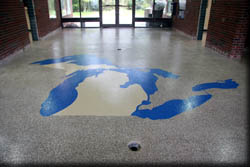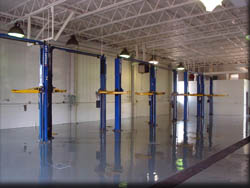Characteristics of Epoxy Coatings
1) Epoxy coatings are used as industrial floor coatings because of their chemical resistance, durability, low porosity and strong bond strength.
2) An Epoxy coating consists of a ‘base' and a ‘curing' agent. The two components are mixed in a certain ratio. A chemical reaction occurs between the two parts generating heat and hardening the mixture into an inert, hard ‘plastic'.
 3) Epoxy coatings yellow and/or chalk when exposed to UV light especially
common when exposed to direct sunlight. This yellowing can be a real problem
for some applications. This can be hidden by choosing a darker color of
pigmented epoxy. Clear epoxies will yellow and may even cloud up. For this
reason epoxies are sometimes top coated with latex, urethanes, and
polyaspartics that will retain their color and attractive gloss. This is
recommending if color stability or matching colors is important.
3) Epoxy coatings yellow and/or chalk when exposed to UV light especially
common when exposed to direct sunlight. This yellowing can be a real problem
for some applications. This can be hidden by choosing a darker color of
pigmented epoxy. Clear epoxies will yellow and may even cloud up. For this
reason epoxies are sometimes top coated with latex, urethanes, and
polyaspartics that will retain their color and attractive gloss. This is
recommending if color stability or matching colors is important.
4) After the two epoxy parts are combined there is a working time (pot life) during which the epoxy can be applied or used. Generally the pot life will be anywhere from minutes to one hour. At the end of the pot life the mixture becomes very warm and further accelerates the hardening.
5) Epoxy Resins will harden in minutes or hours, but complete cure (hardening) will generally take several days. Most epoxies will be suitably hard within a day or so, but may require more time to harden before the coating can be sanded.
6) In theory, a temperature change of 10-15 degrees F. will double or half the pot life and cure time of an epoxy coating. Higher temperatures will lower the viscosity (thin) the epoxy, but also reduce the working time a person has to apply the epoxy.
7) Generally epoxy floors become too thick and cure too slowly to be applied at temperatures below 50 or 60 degrees F. Temperatures between 65 and 85 degrees F are best for installation. After the epoxy has cured, it can handle temperatures well below zero degrees F and in the case of high temperature epoxy coatings above 300 degrees F.
8) Standard epoxy floors will begin to soften at about 140 degrees F, but will re-harden when the temperature is reduced. For common epoxies this temperature is approximate upper end of working temperature range of epoxies. Special high temperature epoxies are available but come with added cost.
 9) By
nature, epoxy resins are hard and brittle. Additives can be added to epoxies
that make them less brittle, but generally at the loss or reduction of other
positive epoxy properties such as chemical resistance.
9) By
nature, epoxy resins are hard and brittle. Additives can be added to epoxies
that make them less brittle, but generally at the loss or reduction of other
positive epoxy properties such as chemical resistance.
10) There are special epoxy formulations that have increased chemical resistance, increased temperature resistance, the ability to be applied underwater and enhance resistance to yellowing and UV damage.
11) Epoxies are expensive, but there are ways to ‘water down' the epoxies with less expensive solvents and/or non-solvent thinners. Diluted down epoxies are common with floor epoxies where pricing pressures are especially strong. To a large degree you do ‘get what you pay for'.
12) Other clues of lesser quality epoxy coatings include ‘induction time' (after mixing the two components the mixture must sit for several minutes to ‘self cook' before being applied).
13) As they cure most epoxy resins ‘blush'. A blush is a waxy coating that forms in the surface of the curing epoxy due to moisture in the air or on the surface of the epoxy coating. This film or blush created must be removed before applying subsequent coats. Most epoxies blush to some degree especially when applied during high humidity.
14) The best time to recoat epoxy is within 12- 48 hours after the initial coat. Because epoxies take days to reach full cure, a second coat applied shortly after the first coat will partially fuse to the first coat rather than just forming a simple mechanical bond. If the recoat “window” is exceeded it is necessary to mechanically abrade the surface to create a mechanical bond for subsequent coats to adhere.
15) While epoxy floors are very common, for serious and demanding applications the epoxy may be mixed with, or applied under and above, quartz (sand) or aluminum oxide grains. Either way, the result is really a quartz or aluminum oxide floor, held in place with the epoxy. The aggregate is much more durable and wear resistant than the epoxy alone.
Service / Market Area:
For industrial and commercial flooring projects we work in Michigan cities such as Muskegon, Grand Haven, Norton Shores, Big Rapids, Cadillac, Reed City, Howell, Lansing, Jackson, Battle Creek, Kalamazoo, Hastings, Plainwell, Otsego, South Haven, Benton Harbor, St Joseph, Holland, Grand Haven, Grand Rapids, Wyoming, Kentwood, Grandville, Portage, Walker, Byron Center, Cascade Township, and Ada. For residential garage projects we generally only bid on work within 30 miles of Grand Rapids, MI.


